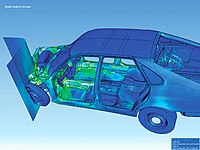
Photo from wikipedia
The aim of this study was to evaluate the biomechanical behavior of Bone Level dental implants with four different neck designs in contact with cortical bone. Numerical simulations were performed… Click to show full abstract
The aim of this study was to evaluate the biomechanical behavior of Bone Level dental implants with four different neck designs in contact with cortical bone. Numerical simulations were performed using a Finite Element Method (FEM) based-model. In order to verify the FEM model, the in silico results were compared with the results obtained from histological analysis performed in an in vivo study with New Zealand rabbits. FEM was performed using a computerized 3D model of Bone Level dental implants inserted in the lower jaw bone with an applied axial load of 100 N. The analysis was performed using four different implant neck designs: even surfaced, screwed, three-ring design and four-ring design. Interface are of bone growth was evaluated by analyzing the Bone-Implant-Contact (BIC) parameter obtained from in vivo histological process and analyzed by Scanning Electron Microscopy (SEM). Bone Level implants were inserted in the rabbit tibia, placing two implants per tibia. The BIC was evaluated after three and six weeks of implantation. FEM studies showed that the three-ring design presented lower values of stress distribution compared to the other studied designs. The lower levels of mechanical stress were then correlated with the in vivo studies, showing that the three-ring design presented the highest BIC value after 3 and 6 weeks of implantation. In silico and in vivo results both concluded that the implants with three-ring neck design presented the best biomechanical and histological behavior in terms of new bone formation, enhanced mechanical stability and optimum osseointegration.
Journal Title: Journal of Materials Science: Materials in Medicine
Year Published: 2019
Link to full text (if available)
Share on Social Media: Sign Up to like & get
recommendations!